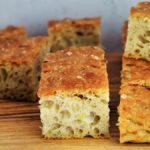
Potato Focaccia
Grated potato helps to create a moist and tasty version of the classic Italian flatbread. In this easy, no-knead recipe a long overnight fermentation also develops flavour.
Ingredients
- 500 g strong bread flour
- 1 tsp instant dried yeast
- 1 tsp salt
- 225-250 g potato, peeled weight before peeling
- 320 - 350 ml water
- olive oil
- sea salt flakes for sprinkling optional
Instructions
THE EVENING BEFORE YOU WANT TO BAKE THE BREAD
-
Put the flour, dried yeast and salt in a large bowl and stir.
Grate the potato into the bowl.
Stir in 320 ml of the water. Mix well, ensuring there are no dry bits of flour, adding a little more water if necessary to create a wet dough.
Cover and leave at room temperature overnight or 12-14 hours.
Tip: if the room is warm then put the dough in the fridge.
THE NEXT DAY
-
The dough should have risen considerably and be very bubbly. If not, leave it longer.
Drizzle a tablespoon of olive oil over the surface of the dough. Rub it all over, greasing your hands with oil as you do so.
Reach down the sides of the bowl, lift up the dough to stretch without tearing it before placing back down, folding the dough over itself. Rotate the bowl a little and repeat the stretching. Rotate and stretch another 6 times, i.e. 8 in total.
Cover and leave to rest for 10 minutes.
-
Grease a large dinner plate with more olive oil.
Scrape the dough onto it.
Fold the dough into thirds by lifting up and stretching one side and folding it into the middle, then lifting up the other and folding to cover the first. Repeat, but this time folding in the opposite direction. Aim to shape the dough into a rough rectangle.
Cover with the upturned bowl or oiled cling film and leave for 15 minutes.
Fold again in both directions, cover and leave for another 15 minutes.
-
Oil the base and sides of a non-stick roasting tray that's a minimum of 25 x 30 cm.
Scrape the dough onto the tray.
Repeat the folding in thirds in both directions, again aiming to get a rectangle shape. Turn over so the seam is underneath.
Cover the tray with cling film (oil it if it touches the dough) and set aside for a second prove.
-
Preheat your oven to 220C / 200C Fan / Gas 7.
-
After approximately 30 minutes*, poke an oiled finger into the dough: if it doesn't spring fully back but leaves an impression then it's ready to bake. If not, leave another 10 minutes and check again. Repeat the checking as necessary.
*Optional: after the first 10 minutes, with oiled fingers gently stretch out the dough so it almost fills the tin. This will give a less deep focaccia, although it will still be quite chunky.
-
When the dough is ready to bake, drizzle or brush olive oil over the top then dimple it by pressing down with your fingertips all over the surface.
Sprinkle with flaky sea salt if liked then put into the oven and bake for 20 minutes.
-
Turn the oven down to 200C / 180 Fan / Gas 6 and bake for a further 8-12 minutes until cooked through and dark golden brown. The bread should sound almost hollow if tapped underneath.
Transfer to a wire rack to cool a little.
-
Best served lightly warm.
Store in an airtight container when cold. Should keep for 3-4 days or can be frozen.
Reheat in a low oven or in a microwave.
Recipe Notes
Recipe adapted from Dan Lepard's in The Guardian Guide to Baking (2007)